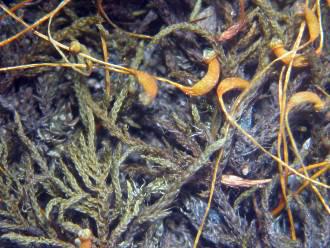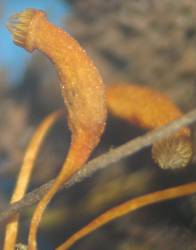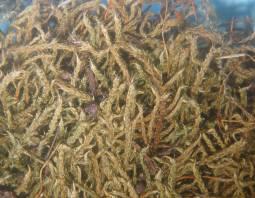Haplocladium angustifolium
Haplocladium angustifolium (Hampe & Muell.Hal.) Broth.
Family: Leskeaceae
Common names: Narrow-leaved small-feathered moss
Introduction
The mosses are a group of non-flowering plants belonging to the Bryophyta division of the main plant kingdom. They are fairly small with most of their features microscopic because they are among the earliest and simplest land plants. The mosses are found in great variety, growing almost everywhere (except in the sea) at all times of the year.

These plants clothe rocks, walls, roofs, pathways, forest floors and tree surfaces, contributing to the beautiful landscapes. They occur most abundantly in relative pollution-free, shady and moist habitats, contributing to environmental status assessment. Some moss species can be easily identified from the field by naked eye or using a hand lense but most tiny species and most moss features are best studied under the microscope. Mosses consist of a vegetative gametophyte (stem and leaves), a sporophyte (fruiting structure) and root-like rhizoids that keep the plant anchored to its substrate.
Haplocladium angustifolium is an irregularly pinnately branched moss that is easily distinguished from other members of the family Thuidiaceae by the leaf apex ending in a long awn; prorate laminal cells (ends of leaf cells projecting above the leaf surface); weakly branched paraphyllia with acute apical cell; and the strongly asymmetrical, curved and inclined capsule.
Description
Description
The small to medium sized plants form yellow-green to reddish brown, flat, loose mats. Stem 20-40 mm long, slender, creeping, prostrate and irregularly pinnate to occasionally bipinnately branching; central strand present. Paraphyllia (small leaf-like scales found on stems or branches) are few to occasionally absent, abundant on youngest parts, simple to weakly branched, 4-8 cells long, 1-2 cells broad at base; cells isodiametrical, oblong, quadrate or rectangular and smooth, upper cells longer, apical cell acute.

Stem leaves and branch leaves are uniform to weakly dimorphic (of two forms), slightly asymmetrical, plane to moderately bi-plicate (folded in two longitudinal pleats) and ornamented on both surfaces.

Stem leaves up to 1.5 mm long including point, and about 0.5mm wide, triangular, broadly ovate or cordate, closely or remotely set and julaceous (smoothly cylindrical, like a catkin). When dry the leaves are incurved, appressed with apex slightly bent away from stem.

When wet they are erect, patent spreading with straight or curved apex. Apex 0.5-0.8 mm long, often abruptly or gradually tapering to a short to long acumen or awn, straight to often recurved or reflexed. Costa (midrib of a leaf) strong, narrow, ends in or above apex, prominent and rough on the back, cells rectangular to linear, smooth to weakly prorulate (very finely papillose). Margins smooth to serrulate (minutely saw-toothed) or lightly denticulate (finely sharply toothed), plane to recurved below. Laminal cells (cells of the upper portion of the leaf) up to 20 µm long, occasionally of more or less the same size and shape except the cells at insertion, oblong, oval to rectangular and unipapillose-prorate (papillose with single papilla per cell). Apical cell acute, elongated, usually hyaline (colourless and transparent) and smooth. Upper cells longer, linear, fusiform (spindle-shaped), sometimes flexuose (twisted) to oval-lanceolate or narrowly elliptic, weakly prorate to smooth, papillae low. Median cells (in middle portion of leaf) weakly flexuose, short and mostly isodiametric (about as long as broad), rectangular, irregularly quadrate, or oblong, prorate to smooth, or occasionally with papillae scattered over lumen (the cell cavity). Basal cells smaller, quadrate or rounded to rectangular, and weakly prorate to smooth. Alar cells (cells at basal margin of a leaf) weakly or not differentiated, smaller, compacted, quadrate-rectangular and oblate (wider than long). Cells at the leaf insertion longer, broader and rectangular.
Branch leaves smaller, 0.3-0.55 mm long, about 0.3 mm wide, ovate to short lanceolate. Apex acuminate, often lacks subula. Costa ends in or above apex, cells rectangular to linear and smooth or prorulate. Margins are smooth to serrulate, plane to recurved below. Upper laminal cells sometimes longer than mid-laminal cells, both oval-elliptic, prorulate or smooth. Basal cells quadrate to rounded, prorate to smooth, papillae often more prominent than in upper cells. Alar cells differentiated, compacted, oblate, quadrate-rectangular, arranged into three to six rows.

Branch leaves smaller, 0.3-0.55 mm long, about 0.3 mm wide, ovate to short lanceolate. Apex acuminate, often lacks subula. Costa ends in or above apex, cells rectangular to linear and smooth or prorulate. Margins are smooth to serrulate, plane to recurved below. Upper laminal cells sometimes longer than mid-laminal cells, both oval-elliptic, prorulate or smooth. Basal cells quadrate to rounded, prorate to smooth, papillae often more prominent than in upper cells. Alar cells differentiated, compacted, oblate, quadrate-rectangular, arranged into three to six rows.
The plant is a utoicous (female and male sexual parts in separate inflorescences on the same plant). Perigonia (male inflorescences) in small open buds on main stem or on short branches, ovate apiculate (abruptly short-pointed). Perichaetia (female inflorescences) sideways on main stem; inner leaves up to 2.2 mm long, oblong- or lanceolate-subulate, -convolute or -mucronate, abruptly apiculate; margins smooth to serrulate, eciliate (without hairy appendages); cells linear, flexuose above and larger below, smooth to weakly papillose; costa ends above apex in a long hair-point. Seta (stalk supporting the capsule) elongate, 10-18 mm long, red-brown below and yellowish above, twisted, glossy and smooth. Capsule 1.2-2 mm long, inclined to horizontal, curved, strongly asymmetric, high-backed, contracted below mouth, yellowish to orange and smooth. Exothecial cells (outermost layer of the capsule wall) irregularly angular or subquadrate-hexagonal, thin walled and stomata absent. Peristome (circular structure in mouth of capsule) perfect with insertion below the mouth; exostome teeth (outer part of circular structure in mouth of capsule) are yellow, yellow-red or yellow-brown, closely cross-striate (having cross bars) below, bordered, papillose and almost hyaline distally. Operculum (lid covering the mouth of the capsule) shortly conical to short-rostrate (with a short beak), convex-pointed and oblique. Calyptra (membranous hood covering the developing moss plant) cucullate (hood-shaped) and often closing below capsule when young, smooth and reddish brown at tip, becoming lighter to white below. Sporophytes (the spore-bearing moss plants) abundant and found throughout the year. Spores spherical, yellowish brown and slightly roughened.
Conservation Status
Status
None.
Distribution and habitat
Distribution description
In southern Africa H. angustifolium is known from Limpopo, Mpumalanga, Gauteng, KwaZulu-Natal, Western Cape, Eastern Cape, Lesotho and Swaziland. This moss is found in forests, along streams, in open grassland, on roadsides, and at the base of walls. The substrates include rocks (granite, ironstone, dolerite, sandstone), concrete, soil, humus, tree bark, tree root and decaying logs. The plant prefers well drained, moist, damp or semi-dry situations in full sun, shade or partial shade at 250-3100 m above sea level.
Derivation of name and historical aspects
History
There are 15 species of Haplocladium (including H. angustifolium) that are widespread in tropical and temperate regions of the world. Another common species is H. microphyllum (Hedw.) Broth. which is widespread in neotropical montane and subtemperate regions in Europe and Asia. H. angustifolium is the only species of the genus known from southern Africa.
Ecology
Ecology
H. angustifolium occasionally grows in association with other plant species including species of Albizia, Buddleja, Salix, Podocarpus, Fabronia, Entodon, Fissidens, Rhynchostegium, Bryum, as well as Leucosidea sericea, Neckera valentiniana, Pelekium versicolor and Racopilum capense.
Uses
Use
There are currently no recorded uses of H. angustifolium for southern Africa but a species of the same genus, H. microphyllum, is used medicinally for tonsillitis, bronchitis, tympanitis and cystitis in China (Glime & Saxena 1991).

Growing Haplocladium angustifolium
Grow
Local information on cultivating mosses is lacking. However, for more information about the cultivation of mosses please visit the website or blog http://www.mountainmoss.com/blog of Annie Martin of Mountain Moss enterprises, North Carolina, USA. She is always happy to share her joy of mosses with others and would like to see moss gardens happen all around the world. In answer to my query she suggested that the same procedures used for the cultivation of pleurocarpic mosses (in which the spore-bearing plant is produced on the side, not at the end of the stem) like Thuidium delicatulum could be followed for Haplocladium angustifolium.
References
- Fang, Y.M. & Koponen, T. 2001. A review of Thuidium, Haplocladium and Claopodium (Musci, Thuidiaceae) in China. Bryobrothera 6: 1-82.
- Glime, J.M. & Saxena, D. 1991. Medicinal uses. Uses of Bryophytes : 31.
- Jewell, A.L. 1964. The observer's book of mosses and liverworts. Frederick Warne & Co. LTD. London.
- Sim, T.R. 1926. The Bryophyta of South Africa. Royal Society of South Africa, Cape Town.
- So, M.L. 1995. Mosses and liverworts of Hong Kong. Biological Department, Hong Kong Baptist University, Hong Kong.
- Touw, A. 2001a. A review of the Thuidiaceae (Musci) and a realignment of taxa traditionally accommodated in Thuidium sensu amplo (Thuidium Schimp., Thuidiopsis (Broth.) M. Fleisch., and Pelekium Mitt., including Aequatoriella gen. nov. and Indothuidium gen. nov. Journal of the Hattori Botanical Laboratory 90: 197-198.
Credits
Nonkululo Phephu
National Herbarium, Pretoria
July 2010
Plant Attributes:
Plant Type: Moss
SA Distribution: Eastern Cape, Gauteng, KwaZulu-Natal, Limpopo, Mpumalanga, Western Cape
Soil type:
Flowering season:
PH:
Flower colour:
Aspect: Shade
Gardening skill: Challenging
Special Features:
Horticultural zones










Rate this article
Article well written and informative
Rate this plant
Is this an interesting plant?
Login to add your Comment
Back to topNot registered yet? Click here to register.